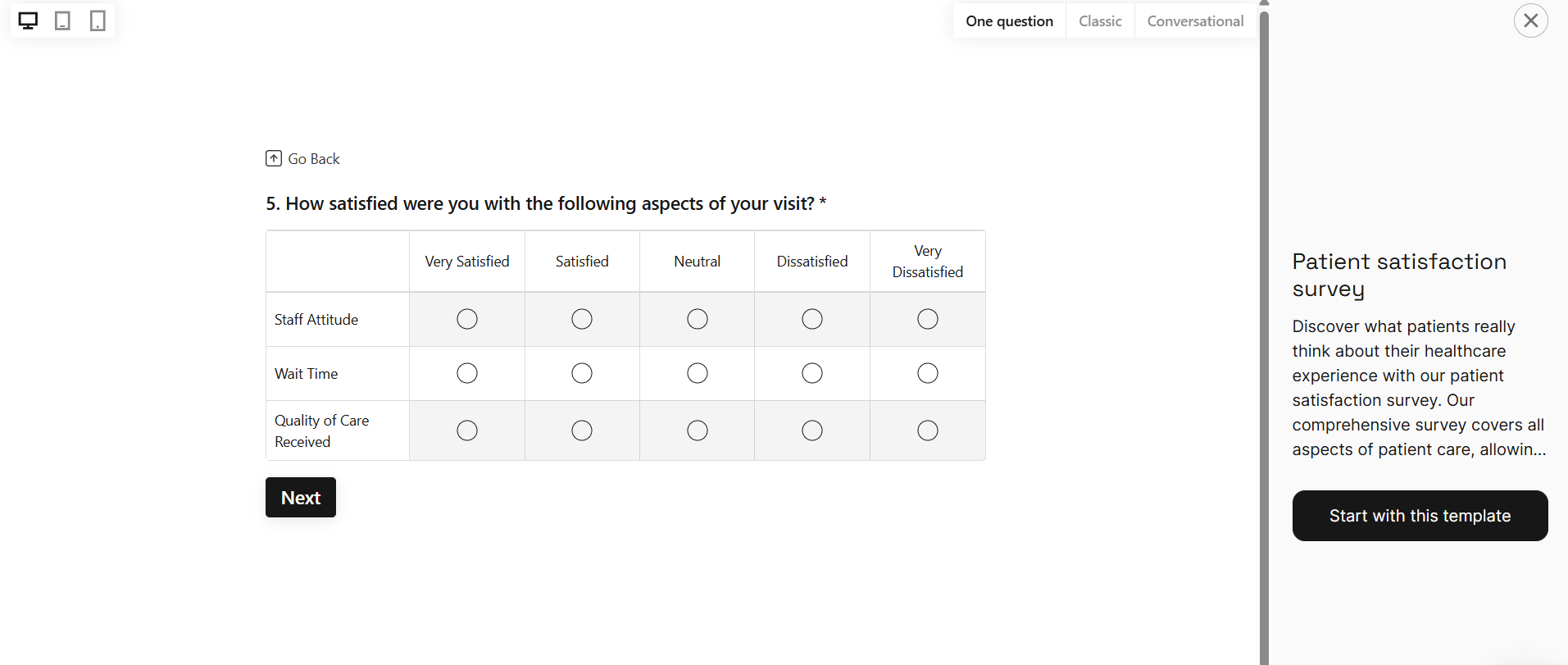Get insights.
Unlock value.
- 14-day free trial
- Set up in minutes
- No credit card required
7 Patient Experience Survey Templates Every Healthcare Practice Needs
You know what's frustrating?
Spending hours creating a patient feedback survey, sending it out to 200 patients, and getting back... 11 responses. Most of them are saying "fine" or leaving half the questions blank.
Or worse - you're drowning in sticky notes, comment cards, and random feedback that goes nowhere.
Your patient satisfaction scores are stuck because you're guessing what needs to improve instead of asking the right questions. You send generic surveys that patients ignore or rush through. Staff keeps hearing the same complaints about wait times, communication gaps, or billing confusion.
The problem isn't that patients don't want to give feedback. It's that most surveys suck. They're too long, too boring, too generic, or sent at the wrong time.
Why Most Patient Surveys Fail (And How to Fix It Fast)
Let's be honest about what's breaking here.
Most patient experience surveys fail because they're built backwards. Someone downloads a random template, slaps the clinic logo on it, and blasts it out without thinking about timing, format, or what they'll actually DO with the answers.
Patients either ignore it completely or fill it out while half-asleep, giving you useless data. Your team can't spot trends. The fix? Stop using one-size-fits-all surveys. Start using templates designed for specific moments in the patient journey - and make them short, focused, and actually relevant to what just happened.
That's where having the right template for the right situation changes everything.
7 Survey Templates You Can Use Today (Without Starting From Scratch)
Instead of building surveys from zero every time, here's what you actually need in your toolkit. Each template is built for a specific part of the care experience, so you're asking the right questions at the right time.
Template Name | How It’s Used | When to Send It |
1. Patient Satisfaction Survey | Captures patient feedback after appointments - wait times, provider communication, and overall experience. Helps identify workflow or staff issues. | Within 24 hours after an appointment via SMS or email. |
2. Patient Health Questionnaire (PHQ) | Screens for depression, anxiety, and emotional well-being in a sensitive, structured way. Ideal for integrating behavioral health into primary care. | During intake or follow-up visits, especially for chronic or behavioral health patients. |
3. Patient Engagement Survey | Measures whether patients understand their diagnosis, treatment plan, and follow-up care. High engagement improves adherence and outcomes. | 1–2 weeks after diagnosis or treatment plan updates. |
4. Cardiac Rehabilitation Satisfaction Survey | Tracks how supported cardiac rehab patients feel - physically, emotionally, and logistically - beyond clinical outcomes. | After key rehab milestones (e.g., 4 weeks, 12 weeks). |
5. Telehealth Satisfaction Questionnaire | Evaluates the virtual visit experience - technology, communication, and perceived quality of care. | Immediately after a telehealth session (auto-triggered via EMR). |
6. EMR Satisfaction Survey | Collects staff and provider feedback on EMR usability, speed, and impact on workflows. Builds a case for system upgrades or retraining. | Quarterly, or after EMR updates or training sessions. |
7. LGBTQ+ Patient Satisfaction Survey | Assesses inclusivity, respect, and comfort for LGBTQ+ patients - a key indicator of DEI success in care delivery. | Ongoing, or as part of annual DEI or patient experience reviews. |
1. Patient Satisfaction Survey
This is your bread and butter. Use this patient satisfaction survey after appointments to capture how patients felt about wait times, provider communication, and overall experience. It's short enough that people actually finish it, but detailed enough to spot patterns - like if one provider consistently gets flagged for rushing through visits or if check-in is always a bottleneck.

2. Patient Health Questionnaire (PHQ)
Mental health screening matters now more than ever. This clinically validated questionnaire helps you assess depression, anxiety, and emotional well-being during intake or follow-ups. It's built to be sensitive and non-intrusive, so patients feel safe sharing what's really going on. Use this if you're integrating behavioral health into primary care.
3. Patient Engagement Survey
Are your patients actually understanding their treatment plans? This patient engagement survey measures how involved they feel in their own care - whether they understand their diagnosis, feel heard by providers, and know what to do next. High engagement = better adherence and fewer no-shows. Low engagement = you've got a communication problem to fix.
4. Cardiac Rehabilitation Patient Satisfaction Survey
If you run a cardiac rehab program, this one's for you. It goes beyond clinical outcomes to measure how supported patients feel during recovery - covering everything from physical therapy quality to emotional support and care coordination. Cardiac patients need long-term encouragement, and this survey helps you see if you're delivering it.
5. Telehealth Satisfaction Questionnaire
Virtual visits aren't going anywhere, but the experience can be clunky. This Telehealth Satisfaction template captures what's working and what's not - tech issues, audio/video quality, provider communication through a screen, and whether patients felt the visit was as effective as in-person. If your telehealth scores are low, this tells you exactly where to improve.
6. EMR Satisfaction Survey
Your EMR system affects everyone - staff, providers, and patients. This EMR survey gathers feedback on usability, speed, accessibility, and whether it's helping or hurting workflows. If your team is constantly complaining about the system but leadership doesn't see the problem, this data makes the case for changes or training.
7. LGBTQ+ Patient Satisfaction Survey
Inclusive care starts with understanding whether your environment actually feels safe and welcoming. This survey asks LGBTQ+ patients about their experience with intake forms, provider interactions, and whether they felt respected throughout their visit. It's a reality check on whether your DEI efforts are working or just performative.
AI Makes This Even Easier
AI can draft survey questions based on your specialty, analyze open-ended responses instantly, and spot sentiment trends you'd miss manually. It's not about replacing human judgment; it's about getting to insights faster without reading through 300 comment boxes yourself.
Stop Guessing What Your Patients Think
Patient feedback isn't optional anymore. It's how you stay competitive, improve outcomes, and keep people coming back.
The difference between clinics that improve and clinics that plateau? The good ones ask better questions and actually listen to the answers.
Stop guessing and start improving. Grab these templates and put them to work. They're built for healthcare, easy to customize, and HIPAA-compliant out of the box and with utmost privacy.
Need help in creating your healthcare survey? Reach out to our team to start your BlockSurvey journey!
7 Patient Experience Survey Templates Every Healthcare Practice Needs FAQ
Why should healthcare practices use patient experience survey templates instead of building surveys from scratch?
Templates save time and ensure you’re asking the right questions. They’re based on proven structures designed for specific patient touchpoints — like post-visit feedback, telehealth sessions, or engagement tracking. Instead of reinventing the wheel, you can start collecting meaningful insights right away and focus on acting on them, not formatting them.
How often should I send patient satisfaction surveys?
Ideally, send short surveys immediately after key interactions — like appointments, discharges, or telehealth visits. Timing matters. The closer the survey is to the patient’s experience, the more accurate and actionable the feedback will be. Long annual surveys usually get low response rates and stale data.
What’s the best way to increase patient response rates?
Keep it short, relevant, and mobile-friendly. Use clear, conversational language instead of clinical jargon. Let patients know how their feedback will be used — people are more likely to respond when they feel their voice leads to real improvements. And yes, send it at the right moment (not weeks later).
How can I analyze patient feedback without spending hours on it?
Use a platform with built-in analytics or AI summarization tools. They can spot trends, highlight recurring complaints, and summarize open-ended responses instantly. This helps you act fast without manually combing through every comment.
Are patient feedback surveys secure and HIPAA-compliant?
They can be — as long as you use a trusted platform like Blocksurvey designed for healthcare data. Always make sure your survey tools are HIPAA-compliant, encrypted, and store responses safely. That’s why many practices choose tools like BlockSurvey, which prioritize privacy and compliance from the ground up.
Get insights.
Unlock value.
- 14-day free trial
- Set up in minutes
- No credit card required


